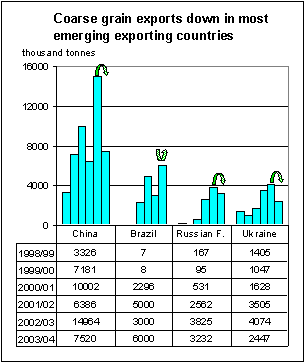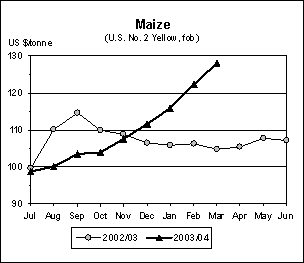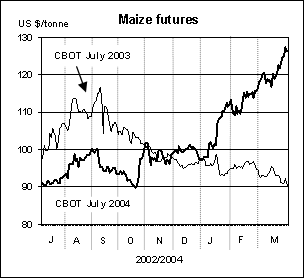


 |
 |
|
 |
||
|
|
||
|
|
|
| food outlook | |
| No. 1 | Rome, April 2004 |
|
CoarseGrainsGlobal coarse grains output in 2004 is forecast at 922.2 million tonnes, 1 percent down from last year but well above the five-year average. Reductions forecast in Africa and North America, would more than offset increases expected in Asia and Europe. This first forecast is very tentative, however, as the bulk of the world’s crops have yet to be planted in the main producing northern hemisphere countries. Coarse Grains Production
Source: FAO. Note: Totals computed from unrounded data.
1/ Including Taiwan Province.
Most of the main 2004 coarse grains are about to be planted in Asia. The region’s aggregate output in 2003 was about average at 213 million tonnes and early indications for 2004 suggest output will remain close to last year’s level. In China, maize output is forecast to increase reflecting the Government’s higher production target. However, this increase may not materialize because of strong prices for competing crops. In India, the bulk of coarse grains are produced during the monsoon season from June/July to November. In the Philippines, the secondary maize crop is in the ground and after generally favourable conditions, a good output above last year and the average is expected. In the Asian CIS countries, winter coarse grains are reported to be in good condition and, with favourable input and moisture prospects for the spring crops, the aggregate output in the subregion is tentatively forecast to increase in 2004. In North Africa, the bulk of the coarse grains crop is grown in Egypt and planting will begin from April. Production in 2004 is tentatively expected to remain above average but will likely be somewhat less than the previous year’s bumper level. Prospects for the winter barley crop in the ground in Morocco are satisfactory. In Western Africa, seasonably dry conditions prevail in the Sahelian zone where the 2004 coarse grain season will start in May/June. The aggregate output of coarse grains in the nine Sahelian countries in 2003 was a record 12.5 million tonnes. Record crops were harvested in all countries with the exception of Cape Verde and Guinea Bissau. In the coastal countries from Guinea to Nigeria rains have started in early March allowing planting of the first 2004 maize crop to begin, particularly in southern areas. Record cereal crops were harvested in 2003 in Benin, Togo and Nigeria while output was below-average in Côte d’Ivoire, Ghana and Liberia. The aggregate 2003 coarse grains production in the eight coastal countries along the Gulf of Guinea is estimated at some 25 million tonnes, virtually unchanged from previous year’s above average crop. In Central Africa, sowing of the main 2004 maize crop, to be harvested from July, is underway in Cameroon and in the Central African Republic. Production of cereals in 2003 in the subregion was average at about 2.7 million tonnes. In the Eastern African subregion, harvesting of the 2003 main season, and most of the 2003/04 secondary season, coarse grain crops is complete. The subregion's 2003 aggregate production is estimated at a bumper level of some 23 million tonnes, 21 percent higher than the 2002 crop. In Ethiopia, although the secondary crop has yet to be sown, the outcome of this will not impact significantly on the aggregate estimate for 2003, which now stands at 8.1 million tonnes, well above the average for the preceding five years. This mainly reflects higher yields as a result of favourable rains and absence of major outbreaks of pests or diseases. A bumper coarse grains production was also recorded in Sudan following favourable weather. By contrast, in Tanzania, the 2003 coarse grains output is estimated at 3.3 million tonnes, 10 percent below last year’s crop and below average due to poor rains. In Somalia, the recently harvested secondary “deyr” season sorghum and maize crops and the main 2003 “Gu” season coarse grains output, harvested last August/September, were reduced and in aggregate the 2003/04 production declined by 28 percent from the bumper crop of the previous year, although it remained about average. In Kenya, the 2004 main “long-rains” cropping season has began and the early outlook is favourable. Harvesting of the 2003/04 secondary “short rains” cereal crop which accounts for some 15 percent of annual production is complete and a slightly below average 360 000 tonnes of maize is estimated. In aggregate the 2003/04 maize output is estimated close to 2.4 million tonnes, around the average of the previous five years. In Southern Africa, the outlook for the 2004 coarse grain crops, about to be harvested, has improved with abundant rains in February and March. However, following the delayed arrival of the rainy season and dry weather in northeastern parts of South Africa, FAO forecasts the subregion’s aggregate coarse grains output at 15.0 million tonnes, about 12 percent below last year’s average production. The forecast of aggregate maize output is 14.0 million tonnes. In South Africa, the subregion’s largest producer, the official forecast of maize production has been revised upward to 7.7 million tonnes, which is still a 21 percent reduction from the previous year. Maize production in Zimbabwe is expected at about 1 million tonnes indicating a slight recovery over the sharply reduced levels of the previous two years, mainly due to improved weather conditions. Prospects for coarse grains are overall favourable in Zambia and Mozambique but unfavourable in drought-affected Lesotho and Swaziland. In South America, harvesting of the 2004 coarse grains is underway in the main southern producing countries. The aggregate output of the subregion is forecast at 76 million tonnes (comprising 68 millions of maize), lower than last year’s record harvest but still above average. In Brazil, where the 2004 main season maize crop is being harvested in the centre-south states, an official forecast points to an output of 34.2 million tonnes, almost unchanged from the main season output in 2003. By contrast, in Argentina, the official forecast points to a decline of 18 percent in the 2004 maize crop to 12.4 million tonnes, partly because of dry weather causing plantings to be reduced and partly because of a lower average yield being obtained. In the United States planting of the bulk of the 2004 maize crop will begin from April. At this early stage, assuming generally normal weather conditions for the season, the aggregate 2004 coarse grain crop (mostly maize) is tentatively forecast to be about average. The final estimate of the 2003 coarse grains crop is 276 million tonnes, almost 13 percent up from the previous year's poor crop and above the average of the past five years. In Canada, the early outlook for 2004 suggests coarse grains production will remain close to the previous year’s level and just above the five-year average. In Europe, although it is still too early to accurately forecast the main spring and summer coarse grain crops, as for wheat, a strong recovery in production is expected after last year’s low drought-affected level. A sharp increase is expected especially among the EU countries, where the spring barley and maize areas are expected to rise following the EC decision late last year to reduce the compulsory set-aside requirement from 10 to 5 percent. Among the CEECs, early indications mostly assume a return to about-average production levels, meaning a significant increase from 2003 in several countries. In the European CIS, the area planted with winter coarse grains is estimated to be up from last year and similar to 2002 when a bumper harvest was collected. However, the bulk of the coarse grains are planted in the spring (April/May). Assuming normal weather, the harvest should recover from the sharply reduced level last year. In Australia, early prospects for the 2004 summer coarse grain crop (mostly sorghum) are very favourable reflecting good rains in the main producing areas. World trade to remain flat for the third consecutive season World trade in coarse grains in 2003/04 (July/June) is forecast at 105 million tonnes. This is slightly higher than the forecast in November and virtually unchanged from the previous two seasons, in spite of a sudden surge in imports by several countries in Europe. International trade in maize is forecast to remain steady at about 79 million tonnes, but trade in barley is forecast to decline slightly, to 15.5 million tonnes and sorghum to increase slightly to 7.5 million tonnes. Trade in oats, rye and millet are also forecast to remain largely unchanged at 1.8 million tonnes, 1.2 million tonnes and 160 000 tonnes, respectively. While on an aggregate basis, this year’s variation in trade seems minimal, important changes are taking place at regional and country levels. Imports are likely to decrease in almost all regions except in Europe and Latin America. In Europe, total imports are forecast at 11 million tonnes, up 50 percent from the previous season. In the EU, imports (mostly maize and sorghum) are forecast to increase by 50 percent to the highest level in 15 years, mainly in response to an 12 percent reduction in 2003 production and very tight supplies of feed wheat. Last year’s drought-reduced production shortfalls have also raised import needs in several countries outside the EU, especially the Russian Federation, Poland, and Hungary. Among the Latin America and the Caribbean countries, imports of sorghum by Mexico are forecast to increase due to strong feed demand. In North America, a strong rebound in production in Canada is expected to result in a cut of over 2.6 million tonnes, or nearly 60 percent, in imports. In Asia, total imports are forecast down by about 1 million tonnes, to 57 million tonnes. The decrease is driven, in part, by dampened import demand for maize, reflecting a contraction in poultry production in countries affected by this year’s outbreaks of avian influenza. Nonetheless, a number of Asian countries are expected to increase their imports this season: in particular, purchases of barley by the IRI and Saudi Arabia are forecast to increase sharply as a result of a growing feed demand. Aggregate imports in Africa are put at roughly 14 million tonnes, at least 2 million tonnes below the previous season. Bumper barley crops in several countries in North Africa would result in a sharp decline in barley imports. In the Sub-Saharan region, maize imports by South Africa are likely to fall below the previous season, based on smaller pace of purchases so far this season and the fact that the price of local maize is below international levels, making large imports before the start of the next season unlikely.  Regarding exports, the situation is very similar to wheat in that a recovery in production among major exporters with the exception of EU, is expected to result in larger sales and hence a recapturing of their global market shares. The biggest increase is expected from the United States with its total shipments rising by over 6 million tonnes from the previous year’s reduced level to almost 54 million tonnes. By contrast, as shown in the chart, among the emerging exporters, only Brazil is forecast to increase its exports, to a peak volume of over 6.0 million tonnes, supported by a record maize production. By contrast, tighter supplies in China are likely to lead to the halving of its maize exports this season, while exports by Ukraine could also decline sharply as a result of high domestic prices. Higher feed and industrial usage Global coarse grain utilization is expected to expand by 3 percent in 2003/04, to 950 million tonnes. Higher demand for animal feed coupled with record use for ethanol production in the United States are among the main factors for this increase. While a strong recovery in the combined coarse grain production in Australia, Canada and the United States is expected to enable those countries to meet the expected growth in their feed demand, the tight wheat supply situation in Europe has given rise to higher feed use of coarse grains in some markets, in particular in the EU. Falling inventories also among major exporters Global coarse grain inventories for crop years ending in 2004 are put at 152 million tonnes, down 23 million tonnes from their opening levels. Total coarse grain stocks held by the five major exporters are forecast at 46 million tonnes, down 8 million tonnes from the previous season. In spite of a recovery in production in the United States, ending stocks in that country are still likely to show a decline as a result of a rebound in domestic use and a surge in exports. Also, stocks in the EU are forecast to drop sharply, following poor harvests in 2003 and strong domestic demand. Nonetheless, the bulk of the anticipated sharp reduction in global inventories would again be on account of China where stocks are forecast to decline by a further 18 million tonnes as a result of a drop in production, high domestic use and continuing exports. Tight supplies lead to high prices Export prices for most coarse grains have been rising steadily since the start of the current marketing season in June. International maize prices even began to surge above the previous season’s levels from mid-October 2003, in response to tighter supplies and strong demand. While the outbreaks of animal diseases in North America and Asia (BSE and the avian influenza) have had some dampening impact on feed grain demand, prices continued to receive underlying support from reduced sales by China, near-record low stocks in the United States and persistent rallies in soybean prices. In March, US maize export price (US No.2 Yellow) averaged US$128 per tonne, representing a gain of some US$24 per tonne since October and as much as US$23 per tonne, or 22 percent, above the corresponding month last year. Similarly, by late March, the CBOT July 2004 maize futures rose to US$36 per tonnes above the corresponding period in the previous season. While maize prices are likely to remain strong for a while, they could recede from the current high levels following larger than expected harvests in Argentina and also improved crops forecasts in South Africa.   |
||||||||||||||||||||||||||||||||||||||||||||||||||||||||||||||||||||||||||||||||||||||||||||||||||||||||||||||||||||||||||||||||||||||||||||||||||||||||||||||||||||||||||||||||||||||||||||||||||||||||||||||